Sauna is but one form of Thermal Experience. Banya’s, Sweat Lodges, IR Cabins, Laconiums, Steam Baths and others fill out the world of Sweat Bathing. There are also the worlds of hot water, cold water, and cold air (Cryotherapy). And for extra fun the multi-experience facilities like Hammans.
Table of Contents:
- Overview of Thermal Bathing
- Taxonomy
- Elements Of A Thermal Experience
- A Variety of Thermal Experiences
- Banya
- Sweat Lodge or Temazcal
- Sweat Cabin
- Infrared or IR Cabin
- Laconium
- Tepidarium
- Caldarium
- Danarium
- Steam Bath
- Multi Experience Facilities
- Thermarium
- Thermal Suite
- Roman Bath
- Victorian Turkish Bath / Roman-Irish Bath
- Hamman / Turkish Bath
- Hot Springs, Onsen, Hot Tubs, Salt Baths and Mud Baths
- Glossary
- Books / References
Common Accurate Terminology – It’s quite difficult to communicate when we have different ideas and definitions of what things are. Accurate terminology is critical for good communication. So this is both an introduction and discussion of some of the wonderful variety of thermal experiences in the world as well as a lexicon and taxonomy of things thermal.
One problem today, particularly in the medical/health/wellness worlds, is a lack of definition for various thermal experiences. Imagine if a doctor prescribed ‘acetaminophen’ for a headache but the pharmacist’s definition was a corticosteroid. That’s what we have today with thermal experiences. Someone will say that a ‘sauna’ helped with their eczema but this, particularly in the U.S. and UK could be a Finnish Sauna, Bio Sauna, IR booth, Banya, Sweat Cabin, Steam Bath, Caldarium or something totally different.
We need to begin using correct and common terminology, particularly in medical/health contexts. As well, in medical/health contexts we need to specify some critical parameters with regard to temperatures, humidity, steam and practice. And practice specified in terms of Sessions, Rounds, the Structure of each Round (time in hot room, type of hot room, time in cold, type of cold, shower/rinse elements, etc.) as these can all make a difference in results. We need to consider and specify the quality of the sauna. A hot box with low benches resulting in considerable stratification, poor ventilation resulting in high CO2, and a lot of radiant from the heater will likely result in very different outcomes than a real sauna with higher benches resulting in more even convective temps, good ventilation providing for fresh air and low CO2, and little or no radiant.

Individual thermal experiences fall in to one of four categories; 1) Hot Air or Sweat, 2) Hot Water, 3) Cold Air, and 4) Cold Water. And then there are some specific multi-experience facilities that combine several individual experiences.
Social – Like sauna, all of these thermal experiences except IR Cabins are social activities and this was and is today a very key element. Besides enjoyment, the social aspect plays a critical role in improved health.
While Finnish sauna is my personal favorite, I also enjoy steam baths, laconiums, caldariums and others. I’ve also had some wonderful experiences in banyas and sweat cabins. You might have different preferences. (click on the image for a larger view).

Note: Primary Heating Mechanism are all perhaps ±20% but give a good idea of the relative contribution of each source.

Heat: Convective, Radiant and Conductive – What distinguishes sauna from other forms of sweat bathing and what’s made it so popular in Europe is an experience of gentle even convective heat with no noticeable radiant and very little stratification.
Sauna is the only thermal experience where bathers are heated almost exclusively by gentle convective heat. A Banya has a bit of noticeable radiant from the oven. Sweat Cabin’s (Kuuma, Other.) have more radiant still and less convection while IR Booths, Laconiums and Tepidariums are primarily radiant (but in the latter two very mass source so very even on all sides). Finally we have steam baths where we’re back to no noticeable radiant while conductive via steam becomes an important element.
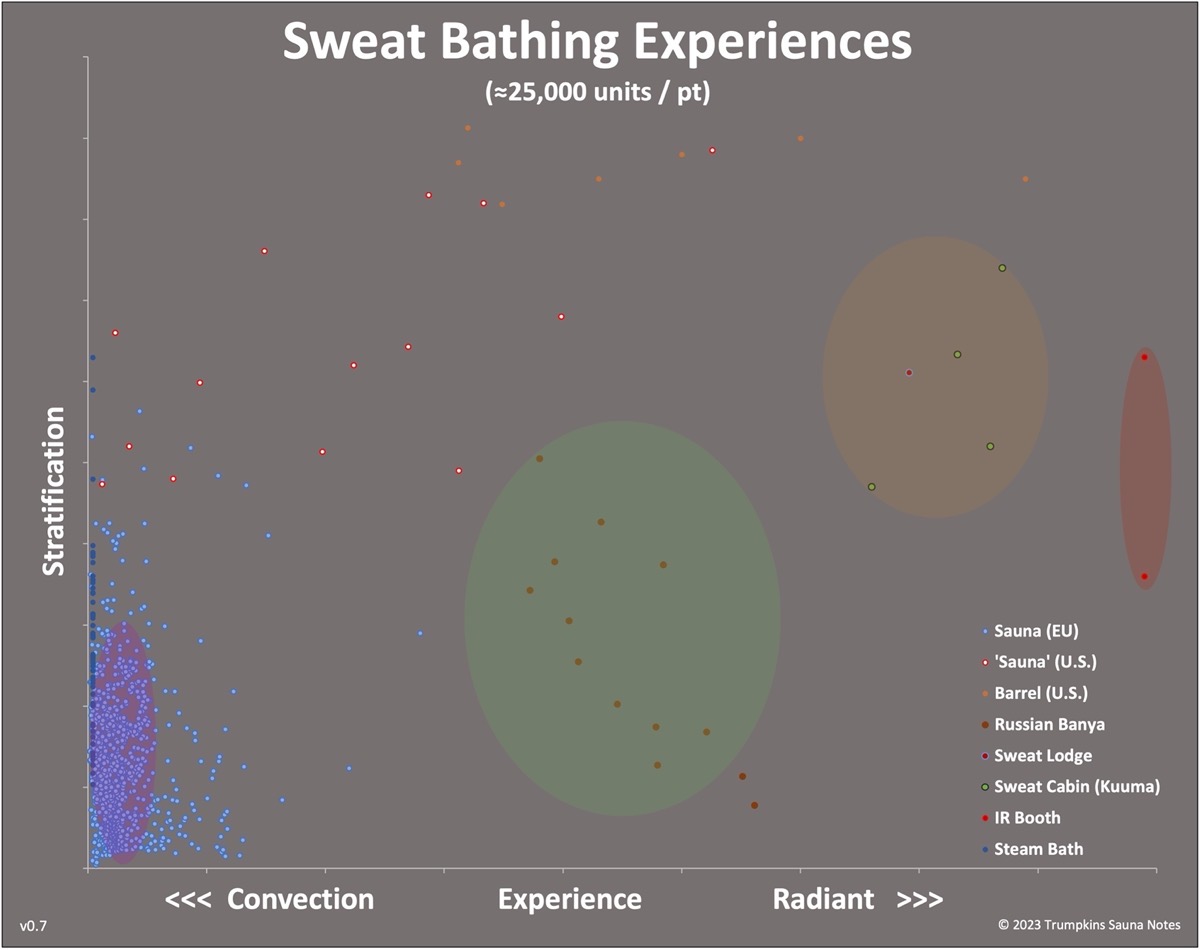
There’s a reason that there are so many saunas in the world and that on our chart they’re clustered down in the lower left corner of convection heat and very low stratification – most people find these to be the most comfortable and enjoyable of all thermal experiences.
A steam bath is actually quite similar to a sauna. There’s a progression of Finnish Sauna > Bio Sauna > Steam Bath (6 o’clock > 7 > 8 o’clock below) of decreasing temp, increasing humidity so increasing conductive heat and with no noticeable radiant. So the Sweat Bathing taxonomy chart above kind of wraps back around from steam bath to bio sauna.
Similarly, the key difference between a bio-sauna and banya is that in a banya we feel radiant heat from the oven on our side facing the oven. Otherwise these are the same from a general temp and humidity standpoint.
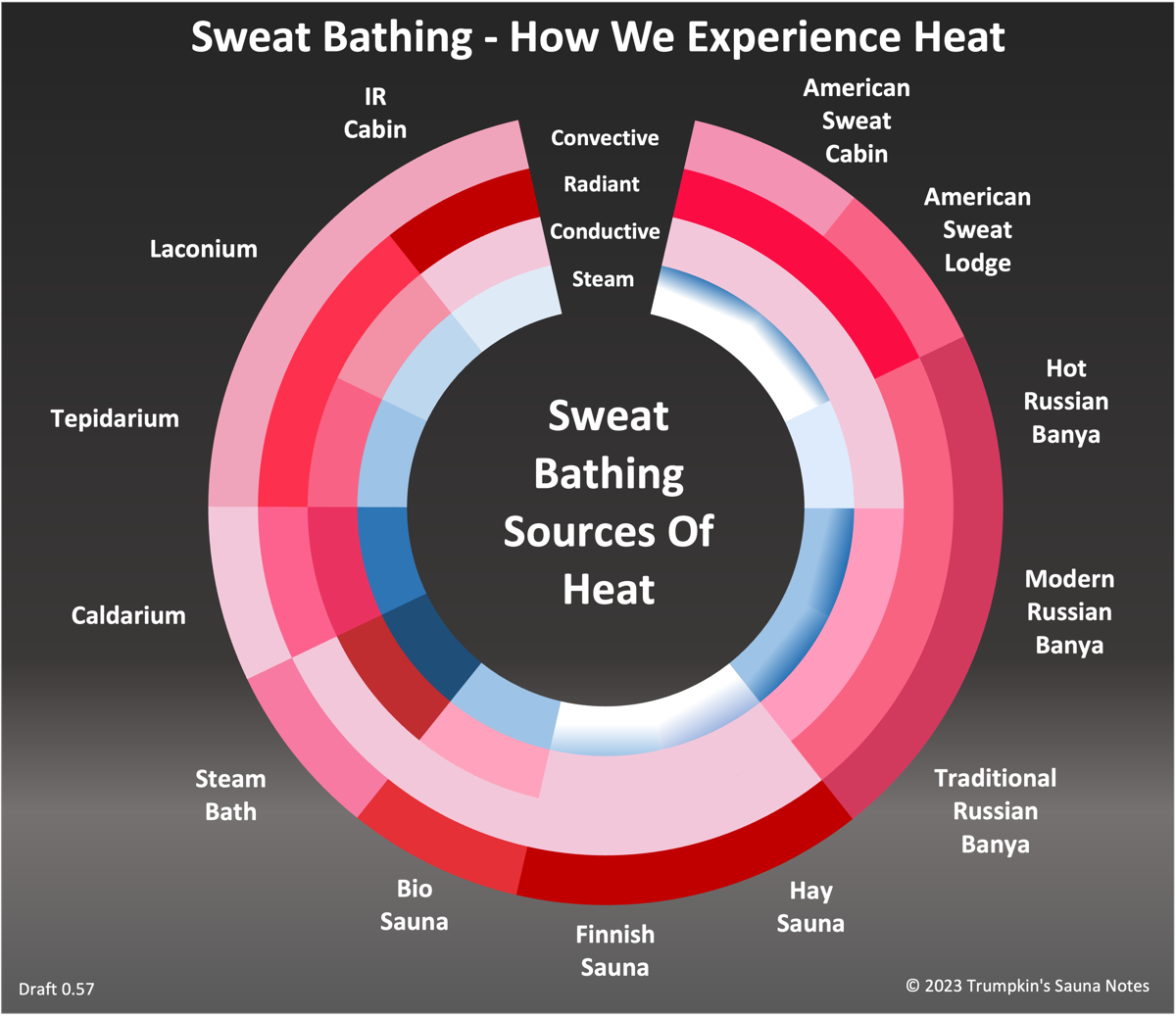
While I prefer a true sauna, as it is known to Finns in Finland, I still enjoy some of these other similar experiences occasionally. Sticky Toffee Pudding, Banofee Pie and Peach Cobbler are three very different foods but I still love all three. I would never try to sell someone Sticky Toffee Pudding and call it Peach Cobbler though. Note: It has taken some bit of work to figure out what’s what with these, particularly Banya. I think I’m getting there but would appreciate any thoughts on making this more accurate.
There are five elements to consider with different thermal experiences; Physical, Setup, Practice, Culture, and Spiritual. Here we are focusing primarily on the first three that are the common foundation regardless of cultural or spiritual elements.
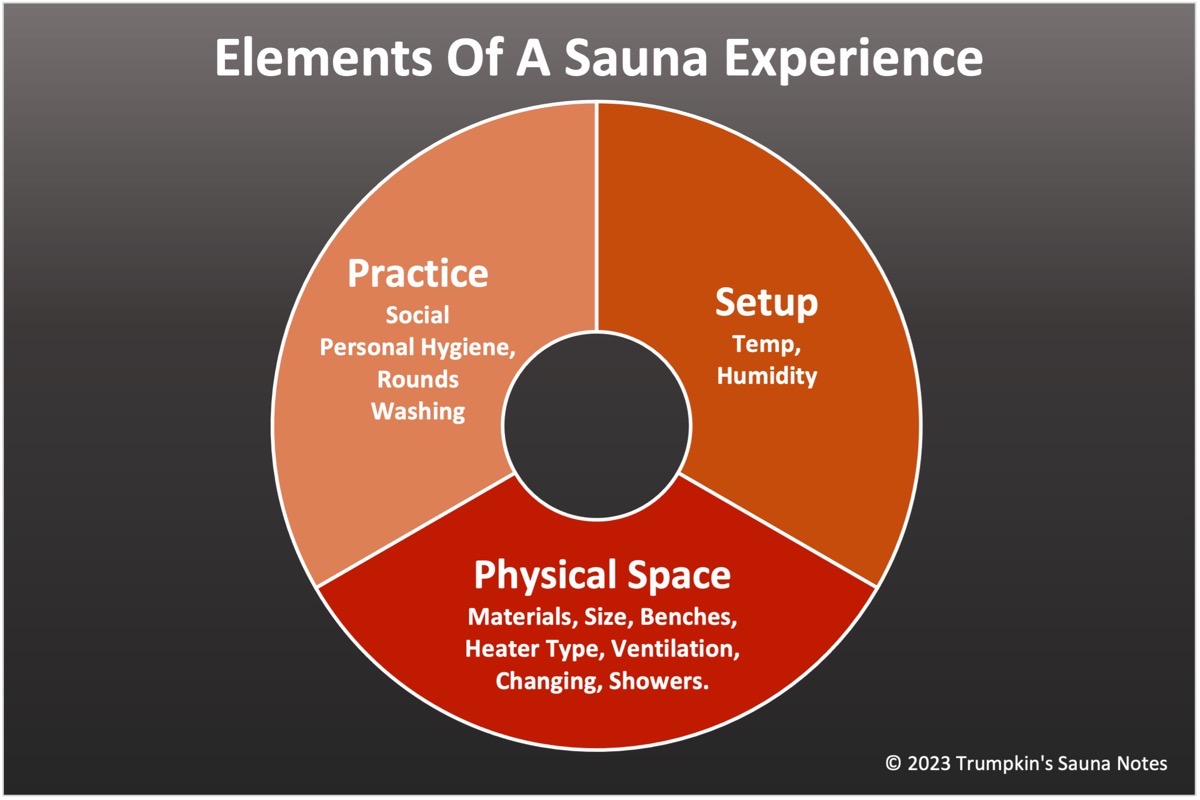
Physical – This is the physical space including thermal rooms and other related spaces. This is fixed and usually remains the same from day to day and decade to decade. This is the foundation for a good experience and getting it right is critical.
Setup – How do we setup the physical space for our use. This is primarily what temp and humidity do we want and how will we control these. It is not uncommon for hotels in Europe to setup their sauna as a Finnish sauna one day and a Bio sauna the next. A home sauna may similarly have the capability to be a Finnish sauna one day, bio another and even setup as a hot yoga studio with 35°c temps and fold-up benches. Similarly a Banya can be a traditional banya one day and a hot banya another day. A steam room w/ heated walls and floor can be setup as a traditional steam shower in the morning and a laconium in the evening.
Practice – How do we use the spaces. Even the best sauna or steam bath will offer a blah experience if we just sit in it for 15 minutes and then take a hot shower. Our routine; showering, cooling off, hydrating is important as are other bits. A sauna setup as a Finnish Sauna can be used individually for multiple hot/cold rounds or have rounds led by an aufgus master. Do we use a vihta? A key part of the practice of banya is Parenie thermal massage.
Cultural – Various thermal experiences are key parts of some cultures or carry cultural significance. Sauna is certainly an important element of Finland’s culture and has been for centuries. And similarly Banya’s in Russia or Onsen’s in Japan.
Spiritual – In many cultures there’s a spiritual element attached to thermal experiences. The North American Sweat Lodge is an important spiritual ceremony. In Finnish sauna history there are elements of both Shamanism and Christianity.
There are a variety of thermal experiences other than sauna. Here are a few of them.
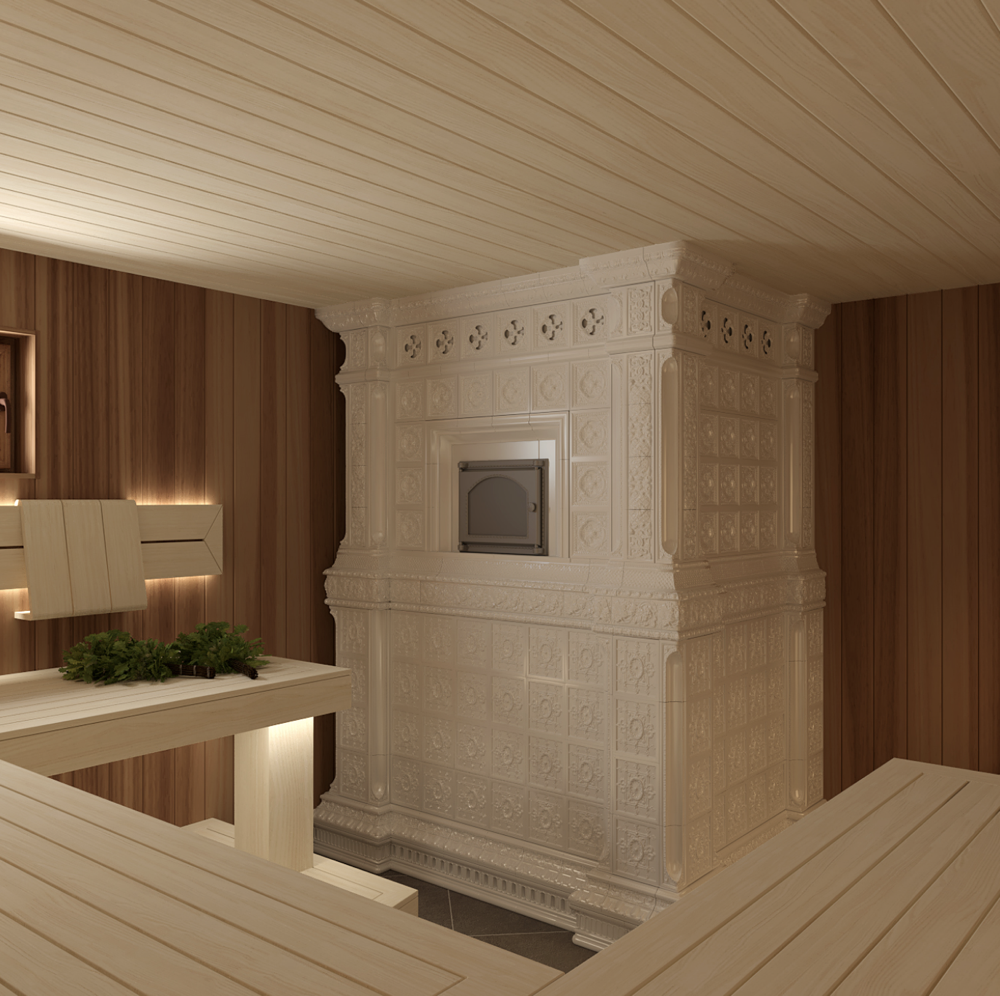
Russian Banya – Banya’s look somewhat like saunas but there are two critical differences; radiant heat from the oven and more intense steam. Banya’s sit kind of in the middle between Saunas and IR Cabins in terms of radiant vs convective heat.
There seem to be four different types of Banya; Traditional, Modern, Hot and Bio.
The steam room or ‘Parilka’ in Russian Banya’s do not have the löyly pocket that is critical to Finnish or Continental saunas. While a key goal in a sauna is to be heated by even convective heat and for there to be no noticeable radiant heat, there can be intentional and considerable radiant in a Banya where the very large floor to ceiling oven produces a large though also quite even, milder and more comfortable radiant than a smaller oven or stove.
Due to the radiant heat, Banyas may have only two bench levels compared to the three bench levels that are critical for löyly in a sauna so banyas often have more convective stratification but since convection is not as prominent this isn’t as noticeable. Banya’s also often have someone, a bath attendant or anyone in the banya, moving the air around to help even out the heat and steam. It is likely that the idea for the aufguss masters popular in continental saunas came from the bath attendants in banyas.
Traditional Russian Banya stoves or ‘ovens’ (above) are much larger and more enclosed than a sauna heater and also function somewhat similarly to a steam generator compared to the open convective dryer heat of a sauna heater. These ovens are designed to contain the heat and steam within the oven carcass for a period of time so that internally it is much hotter than a sauna heater.
Then the very large stone slab or tile surface that’s producing radiant heat is able to produce a ‘softer’ radiant that is more even on bathers since it is less point-source than a smaller stove and because of the size of the radiant surface the radiant heat dissipates much slower so a moderate amount of radiant produced by the oven can be felt more evenly by bathers.
Steam is produced lower in the oven so that, thanks to the higher internal temps (and often extra steel ingots) it can be further heated or superheated before exiting the oven and entering the bathing space.
Want to build your own?
There is also a smaller Modern Banya oven that can look somewhat similar to a sauna heater but differs in several ways including usually having heavy steel or stone slabs for the carcass that creates radiant heat. There is often a water supply or reservoir that constantly drips water on to the stones (and sometimes directly on to the steel firebox or on the lower stones that creates a faster/hotter steam). These may also have a pot of water hanging over the stones that constantly drips water on the upper stones to help maintain the higher base humidity. Many Russians say that these are inferior to the larger traditional ovens because the radiant heat and steam are more harsh and not as even. Builders will often do floor to ceiling stone slabs on the walls behind these to help provide somewhat more even radiant to sort of emulate a larger traditional Banya oven.
(Note: by creating steam from the lower stones or the steel on top of the firebox it’s likely that the steam then becomes superheated.)
Parilka’s typically have somewhat more constant base humidity, similar to a bio-sauna, vs the contrast of very dry with short bursts of steam in a Finnish Sauna. When steam is created in a Parilka to raise the humidity it will decline slowly over perhaps 20-40 minutes. In a Finnish sauna the steam is exhausted within about 2 minutes so we can experience this dry/humid contrast two or three times during each round.
Steam in a banya is more intense than that in a sauna. For the first few minutes after steam is created it can be impossible to sit on the upper bench and hats are more of a necessity because of this. The greater intensity of the steam is likely due to it being created by water on steel rather than water on stones. Banya ovens will often have steel ingots in them both for heated mass and to create this more intense steam. With modern banya stoves the intensity can be somewhat controlled by adding steel stones in with the regular stones. These are sold in Russia in a variety of shapes for this purpose.
Banya is traditionally lower temp (65°c ± 15°c / 131°f ± 27°f ) + higher and more constant humidity (30-70% RH) than a Finnish Sauna. There is also a Hot Banya experience that is quite high temps, about 140°c, and very low to nearly no humidity. Some Russians will treat their Parilka somewhat like a Sauna with lower humidity and temps around 80-105°c though a major difference is that the oven in these is producing more radiant heat than would a sauna heater. There is also what I think can best be described as a Bio-Banya that, similar to a bio-sauna, is slightly lower temp than traditional banya and somewhat higher humidity of perhaps 50%. Bio-banyas still have the traditional radiant heat of a banya.
Banya includes Parenie thermal massage, sometimes called Platza, as an essential element, typically by a masseuse (called a banshik in a banya) using a venik of birch, oak or eucalyptus. Note that ‘per’ means steam in Russian and that the key element here is that this is a steam massage. Using a venik is optional and less formal with sauna and often done by the bather themselves or whomever is sitting next to them. Banya masseuses prefer the more intense and highly stratified banya steam to the more gentle and less stratified steam in a sauna. They say that it gives them more control. When they reach up high with the venik it is not for show but to ‘grab’ a bunch of the steam and bring it down to their patient. Between massages they will open the door to let the steam out so that they can create new very stratified steam for the next massage.
While saunas in Finland nearly always include a changing room, I’m told that having three rooms (steam or ‘parilka’, washing or ‘moyka’ and the critical ‘predbannik’ for relaxing) is essential to Banya.
Interestingly Russians will often say that Banya is just like Finnish Sauna while Finns say, rightly, that it is very different. This is likely because someone who is accustomed to no noticeable radiant in a sauna will notice the radiant from the banya oven while someone accustomed to the radiant + convection may not be as likely to notice the absence of radiant, especially if convective temps are very even.
For more on Banyas: Bryon MacWilliams book ‘With Light Steam’ and Ethan Pollock’s ‘Without The Banya We Would Perish’ are both excellent.
A Tale Of Two ‘Banyas’ compares two banyas in London; a genuine banya, and a bio-sauna dressed up like a banya.
How a banya oven is built includes some interesting material (Note the lack of stones or any convective air flow in this oven so this one will produce a very radiant experience. Some banya ovens do have stones (In addition to or in place of steel ingots) and some airflow up through them for kind of a balanced radiant-convective experience.)
Thanks to Dr Mikhail Brodsky, Andrej, Anna, Sergei and others for providing me with so much valuable information about banyas.
Sweat Lodge or Temazcal– These are common among many Indigenous Americans and seem somewhat similar to a Finnish Smoke Sauna except that typically the stones are heated outside and then carried in to the tent. Sweat lodges are more radiant heat vs the convective heat of a sauna. Sweat Lodges are also a spiritual ritual, sometimes referred to as an Inipi ceremony, for many Indigenous Americans.
Sweat Cabin – These are heated by heavy steel stoves such as Kuuma, Nippa and others. Many in North America call these a sauna, though they are actually quite different. These are kind of a hybrid of a Sweat Lodge, Banya and IR Cabin. They have radiant heat from a heavy steel stove rather than the convective heat and convective loop of a sauna. These generally do not have the löyly cavity that a sauna has. They will often have lower ceilings and benches since with the radiant heat there is less benefit to higher as there is for a Sauna with convective heat. In practice bathers will typically use them like a Finnish Sauna by throwing water on the stones to increase humidity. In this they are perhaps similar to a Modern Banya though with harsher and less even radiant heat and less convective heat.
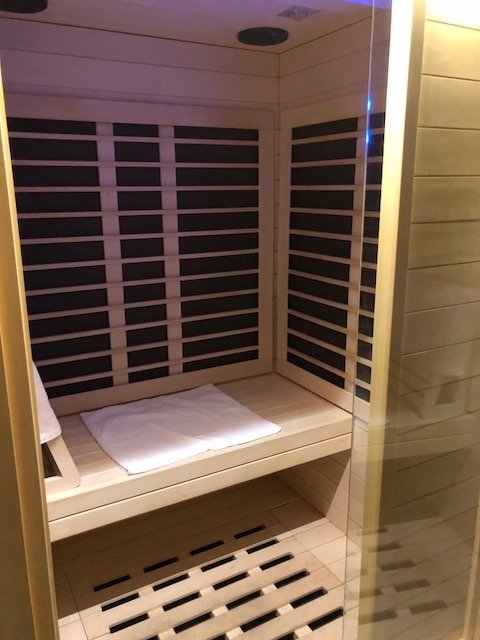 Infrared Cabin – This is not a sauna despite the misappropriation of the name in the U.S. and is a very different experience than sauna despite what marketing people say. Most people who have experienced both usually have a preference, often strong, for sauna.
Infrared Cabin – This is not a sauna despite the misappropriation of the name in the U.S. and is a very different experience than sauna despite what marketing people say. Most people who have experienced both usually have a preference, often strong, for sauna.
There are two flavors of IR; Far Infrared or FIR and Near Infrared or NIR. Each is a bit different from a comfort/enjoyment standpoint. Both FIR and NIR include potential health benefits though the lists of benefits differ for NIR, FIR and Sauna. One studied benefit is using FIR for Waon Therapy to improve respiratory function for people with COPD. Other health benefits are being studied so as time goes on we’ll know more. There are some health concerns with IR such as EMF exposure though similar to the benefits these have not yet been studied enough to know if they are real or imagined.
Laconium – A Laconium (≈ 60°c, naturally dry) looks similar to a Steam Bath with its stone or tile walls. It functions more like an IR Cabin though as the floor and walls (and sometimes ceiling) are heated and radiate this heat to bathers. A Laconium provides a more even and pleasant heat than an IR Cabin and typically has very low humidity though bathers can throw water on the walls to raise the humidity as they desire.
Thanks to the more even very mass source radiant heat and larger space, laconiums are more social than an IR booth.
Tepidarium – A Tepidarium (≈ 37°c (body temp), semi dry) is similar to a Laconium in that bathers are heated by radiant from the stone or tile walls and floor but the ambient temperature is lower and humidity may be slightly higher. Loungers are heated as well and are noticeably warmer, typically 37°c. Today they are often used as a room to lay in after a massage. Bathers typically lay naked though sometimes swaddled in a blanket.
Caldarium – A Caldarium (≈ 40-50°c, near 100% humidity) is similar to a steam bath with the primary difference being that a caldarium includes radiant heat from the walls and floor.
Danarium – A low humidity Steam Bath (≈60°c, 60% relative humidity) or Caldarium without the radiant. It’s built like a steam bath but for use is setup with temps and humidity that are actually quite similar to a Bio-Sauna.
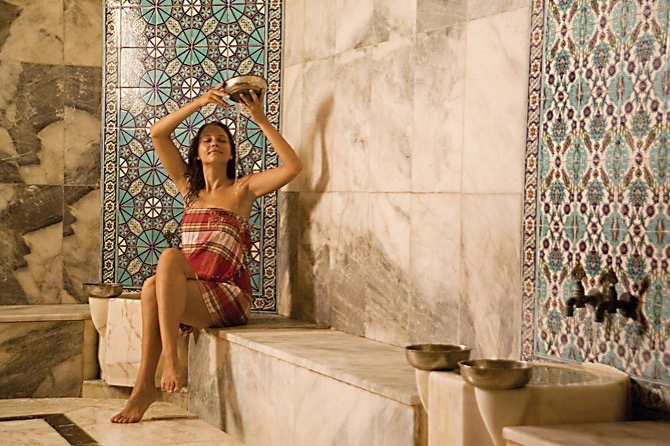
Steam Bath / Steam Shower – Lower temperature (40°c ± 10°c / 105°f ± 20°f ) and very high humidity of 90-100%. If you think about a humidity continuum from Finnish Sauna to the moderate humidity of a Bio Sauna, a Steam Bath is simply the next step. It’s kind of a Caldarium without the radiant. Rather than the wood walls of a Sauna the walls of a Steam Bath are typically tile or stone.
Steam Baths do appear to have a number of health benefits, some overlapping with Sauna. There may be a higher risk of bacterial transmission in a Steam Bath so hygiene of bathers and the facility is critical.
Fun stuff: What we see in a steam room isn’t actually steam, which is invisible, but rather lower temperature fog.
Ozone Cabin – Similar to IR Cabins these are not saunas in any way except the misappropriation of the name. These are not always a thermal experience.
![]()
Individual thermal experiences are rarely alone but are often combined for a more multi-dimensional experience.
Thermarium — Kind of a steam room plus. A thermarium is a stone/tiled space that includes heated walls, floor and possibly ceiling along with a steam generator to provide the experiences of a laconium, caldarium, danarium, steam bath and maybe also a tepidarium. These capabilities can be included in a steam shower or steam room. Heating is typically via hydronic but can be electric as well.
It can also be possible for a thermarium to function as a chill room.
Ideally for a shared space this room should be about 10’ x 8’ x 8’ for a single tepidarium lounger and 10x10x8 for two loungers. As small as 5x5x8 can possible work though. Ideally the tepidarium lounger is not directly next to a wall so that bathers feel even gentle radiant from all around rather than more intense from the left or right.
There is a great opportunity for a company like Kohler or Masco to offer a single integrated system for this (including controlled ventilation to maintain healthy CO2 levels).
Thermal Suite — A Thermal Suite is a dedicated area with a collection of thermal experiences found in a home, flat, office, hotel or dedicated facility. This suite of thermal experiences can be inside, outside or both.
A thermal suite includes four key elements; Hot, Cold, Rest, Rinse. Bathers should be able to easily move about these comfortably nude.
A good thermal suite for a private home might be a central commons area with lounge chairs, a 4-person plunge pool (16°c / 150x300x120d (5’x10’x4’)) and four showers, a 4-person sauna and a 4-person thermarium. This central area should have easy access to outside and ideally some large openable windows/doors to see out, let sun, moon and star light in and provide for fresh air. A conservatory or orangery can work well for the central area.
For more see ‘Thermal Suites’ in the top menu.
Roman Bath – Roman Baths are perhaps the best known of ancient thermal bathing and from where we get Laconium, Tepidarium, Caldarium, Frigidarium and other bits. Roman baths are however likely descendants of Greek bathing activities (and laconium likely from the Greek laconia) which are themselves likely based on more ancient activities.
Roman Baths often had a more formal proscribed ritual done in a larger multi-room facility. It is believed that a typical ritual was Tepidarium (warm) > Caldarium (hot) > Frigidarium (cold). Some however appear to have been built for a specific Caldarium > Tepidarium > Frigidarium. Alternate rituals might have included a second stop in the Frigidarium. Many also included a Laconium (hotter (60°c ?) and dryer than a Tepidarium).
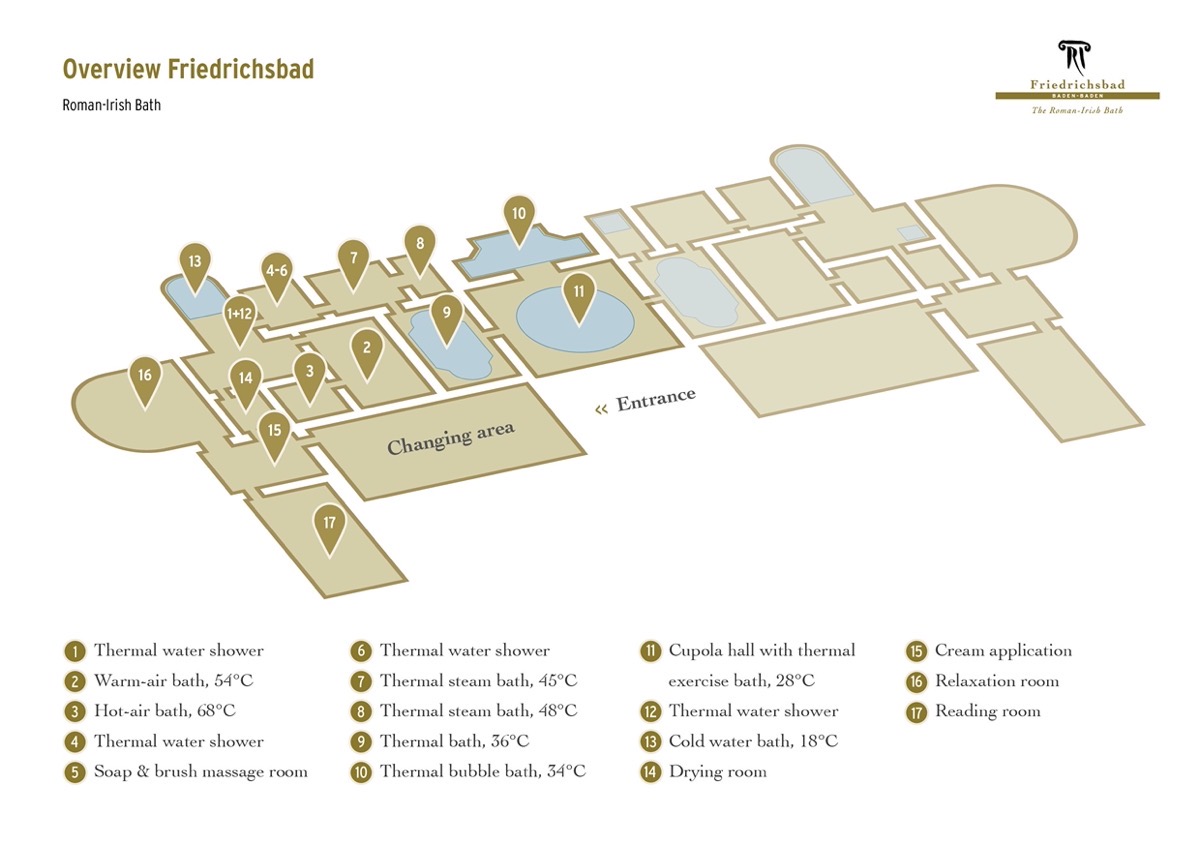
Victorian Turkish Bath / Roman-Irish Bath – Victoria Turkish Baths and Roman-Irish Baths are descendents of Roman baths and believed originated by Dr. Richard Barter in the mid 19th century. Despite the name, Victorian Turkish Baths are actually somewhat different from Turkish Baths. Generally the best Roman-Irish today is considered to be Friedrichsbad Spa (plan above) in Baden-Baden Germany with their 17-step process. Some interesting info at VictorianTurkishBath.org
Hamman / Turkish Bath – These are descendants of Roman Baths from when Rome controlled the Maghreb (Northern Africa) and what is today Turkey. The Roman baths had become very popular among the Muslim populations of these areas and over time were adapted as a cleansing ritual in Islam.
Lassi provides a good discussion here: Is hammam a sauna? Comparing two iconic thermal experiences and more here: The Timeless Hammams of Istanbul. Note for U.S. citizens… In 2023 USDOS upgraded Turkey from Level 1 advisory (normal) to Level 2 (increased caution). In their 7 May 2025 review they noted that going to Level 3 was considered but they’re holding at Level 2 for now. FWIW, I do a lot of Int’l travel and so long as you exercise a bit of caution, keep your eyes/ears open (and for L2 & L3 register w/ STEP) I think it’s still safe to travel to Turkey.
Hot Springs, Onsen, Hot Tubs, Salt Baths and Mud Baths are other more liquid forms for thermal experiences. For the ultimate hot springs and mud baths experience spend a week in Bormio Italy. You can hike to mountain huts for lunch during the day and then enjoy a hot spring, mud bath or sauna in the evening before having a wonderful dinner. The Onsens of Japan (there are three varieties; rotenburo, utaseyu, and konyoku) are something everyone should experience once in their life.
Snow Rooms, Cryotherapy and similar cold air experiences are also popular options in this realm.
At spa’s throughout Europe you’ll find numerous other experiences like salt water floating pools, Kneipp walks and brine cabins.
Getting a bit outside of thermal experiences; Halotherapy is an experience of breathing salt air which can help with a number of ailments. A human-made room for this is sometimes called a Broncharium which will typically have a temp of about 20°c (68°f) and either have walls of salt (typically Himalayan) or a salt air generator. Speleotherapy or Spelarium is the real cave version where you actually enter a salt mine. A Spectaculum is sound and light therapy.

Accurate and clear communication requires a common understanding of what various words mean. Often a tighter or stricter definition results in more accurate communication.
Note: Also see the glossary in the back of the Global Wellness Institute’s Hydrothermal Guide.
After Löyly – Sitting on the upper bench of a sauna after it’s cooled a bit to enjoy the warmth of the radiant heat from the wall on bathers back.
Alpine Bathing Tradition / Alpine Sauna – Very similar to Continental but includes a Hay Sauna.
Aufgus – Technically this means ‘infusion’ but in common use today it’s a ritual performed by an Aufgus Master or Sauna Master that may include a variety of infusions, towel waving to distribute heat, steam and infusions, dance and other elements. Likely originated from an older and somewhat similar ritual in Russian banyas. There are four categories of Aufguss:
- Classical or Traditional – Focused on the sauna experience so air movements are purely to mix in the infusions and reduce stratification.
- Modern – Adds music and a bit more flair to the routines.
- Ritual or Zen – “Take guests on an inward journey, including meditation, yoga, sound bathing or breathwork”.
- Show or Theatrical – Saunamiesters often wear costumes and tell a story.
Bastu – Swedish version of a sauna. While Finn’s frequently tease their neighbor’s by saying that their Bastu’s are not as good as saunas, there is really little to no difference.
Bio-Sauna – A sauna that is lower temperature, typically about 65°c, and higher and more constant humidity. This is sometimes also called a Soft Sauna in North America. While bio-sauna isn’t a great term, soft sauna might be confusing because a traditional Finnish sauna and in particular the steam is often called soft and soft steam is highly desirable.
Caldarium – A room, typically of tile or stone slabs, where bathers are heated primarily by soft radiant heat from the walls, floor and often the ceiling. Temperatures are about 40-50°c with moderately high humidity.
Cold Feet / Cold Toes – An expression in Finland for anytime feet are more than about 20% cooler than our head or steam doesn’t fully envelope our feet. For example, if the temperature at our head is 90°c and the temperature at our feet is less than 72°c then we have cold feet.
Continental Bathing Tradition / Continental Sauna – Centered in Austria, Germany, Netherlands, Switzerland, northern Italy and Sweden. Includes a variety of sauna and other experiences as part of a well thought out thermal suite. Everyone in saunas, steam baths and similar are required to be nude, shower first, sit on a towel, and often place a towel under their feet. Sexes are typically mixed. Sand clocks for timing how long to stay in are common. Outside of aufguss, bathers will often wave a towel around themselves to distribute heat and steam though this seems to be diminishing as they adopt more Finnish style saunas with higher benches and downdraft ventilation.
Danarium – A room, typically of tile or stone slabs, where bathers are heated by soft radiant heat from the walls, floor and often the ceiling as well as by the latent heat in steam. Temperatures are about 60°c with 60% humidity.
Day / Session – A series of hot/cold rounds. We typically do multiple Rounds per day or session.
Finnish Bathing Tradition / Finnish Sauna – Focused on sauna. Typically 70-105°c. Bathers create steam by throwing or pouring water on the stones of the heater. Everyone in saunas, steam baths and similar are usually nude though not always. Family and close friends are mixed sex, otherwise sexes are separated, typically with women first with lower temps and then everyone is welcome to join. Sand clocks are rare and people stay in as long as they feel comfortable.
Foot Bench – The second highest bench and the one that we put our feet on when sitting on the sitting bench. The foot bench is typically about 40cm (16”) below the sitting bench.
Gradier Sauna – Somewhat similar to a hay sauna. Temp about 55°c. In the room is a graduation tower of blackthorn with a brine (salt water) dripping over the blackthorn to create a natural infusion. The use of brine may result in production of negative ions (a good thing) though there is no proven evidence.
Graduation Tower – A wooden tower filled with brushwood (typically Blackthorn) that results in concentrated salt air. Wiki: Graduation Tower.
Hay Sauna – A sauna that includes some walls lined with natural local hay. These are seen primarily in alpine areas.
Kiuas – Finnish word for a sauna heater. A Kiuas is a very specific heater that produces convective heat (via stones) and very little radiant heat. It has a large mass of hot stones upon which water can be thrown to produce steam. The heater itself is low in mass and thermal production/storage.
Laconium – A room, typically of tile or stone slabs, where bathers are heated primarily by soft radiant heat from the walls, floor and often the ceiling. Temperatures are about 50-70°c with low humidity.
Law of Löyly – Also known as Pälsi’s law or the Law of Steam. The Law of Löyly states that the foot bench of a sauna must be equal to or above the top of the heater stones in order to avoid cold feet.
Light Steam – Steam that is very buoyant and stays near the ceiling longer before dispersing downward. Light steam is very desirable in Russian Banyas. See also ‘Steel Steam’.
Löyly – Finnish word for “the purity, freshness, temperature, humidity and evenness of the air in the sauna”.
Löyly Pocket – A space in a sauna where temperatures and steam are even and most comfortable – and where we want our entire body to be. This is usually in the half of the sauna most distant from the heater, in the upper 2/3 of the space and 10-20cm above the top level of the stones.
Mixed Sauna – A sauna shared by both sexes and where everyone is nude. This also applies to other thermal experiences such as steam rooms as well as thermal suites and sauna worlds as a whole.
Novelty Sauna – A sauna that is poorly designed/built and that novices love while a new and novel experience but as the novelty wears off so to the use. These do not provide the compelling experience that real saunas do and that people crave using for decades.
Pirts – Latvian version of a banya. Pirts has more of a spiritual significance in Latvian culture than banya does in Russia.
Recovery Suite – A space dedicated to recovery from a workout or other bit of exertion. Typical elements might include massage, assisted stretching, compression, light therapy, O2 cabins, lounge/rest areas or other bits. Thermal elements can be a part of this though it is often best for the thermal suite to be separate.
Round – A contrasting sequence of Rinse > Hot > Cold > Relax > Hydrate > Repeat. Rounds are typically repeated numerous times during a sauna session. An average perhaps is 3 rounds per session but more or fewer is not uncommon.
Sitting Bench – The highest bench. Typically about 110-130cm (44-51”) below the ceiling though this can be greater in larger commercial saunas.
Sauna Master / Aufgus Master – Someone trained extensively in the use and benefits of sauna. Their primary role is to guide bathers in proper use and etiquette of a sauna. An add-on role is managing temperatures and steam during a sauna session and sometimes that of entertainer. The sauna master is likely descended from the bath attendants in Russian banyas that have provided a similar roll for over a century and likely for multiple centuries.
Soft Sauna – See Bio-Sauna.
Steel Steam – Steam created mostly or entirely from steel. Steel creates steam faster than stone resulting in a more dense and thus hotter feeling steam. It can also be superheated (>100°c) which feels hotter and has greater buoyancy so will stick near the ceiling longer before dispersing downward. In a Russian Banya this is called ‘light steam’ and is highly desirable for a good parenie massage. Steel steam is sometimes described as ‘biting’ or ‘stinging’. Banya ovens and stoves as well as stoves from Kuuma and Scandia are known to produce steel steam.
Stone Steam – Stones store heat more than steel and release heat slower so produce steam more slowly and rarely if ever produce superheated steam. Stone steam is more gentle than steel steam, though can still be very intense, and disperses down around our body faster.
Tepidarium – A room, typically of tile or stone slabs, that includes heated loungers. Bathers are heated by soft radiant heat from the walls, floor and often the ceiling as well as conductive heat from the lounger. Temperatures should be body temperature of 37°c with moderate humidity.
Thermal Suite - A space with multiple thermal experiences. Typically including four key elements; hot, cold, rest, rinse. Often includes at least a sauna, steam bath, cold plunge, showers and rest/relaxation areas. These areas are typically textile-free (nude) and so usually at least partially partitioned from textile areas.
Thermarium – A room that provides capabilities to be setup as a steam bath, laconium, caldarium or danarium and in many cases also a tepidarium and/or chill room. It’s basically a steam bath with heated floor, walls and ceiling. The amount of heat (or cold) radiated from the different surfaces along with the humidity provides for a variety of experiences.
Characteristics of Steam:
Attack – The initial period as steam is first building after pouring water on the stones.
Peak – The point or period of highest humidity.
Decay – The period after steam has peaked and is slowly declining in intensity.
Rest – The period between decay and the next attack.
Sustain – A period where the level of steam remains fairly constant. This can occur during any of the three temporal envelope phases.
Temporal Envelope – The active period that encompasses Attack, Peak and Decay.
Dispersion Speed – How quickly does steam disperse, particularly across our body from our head to our toes.
Dispersion Eveness – How even is the steam across our body – does it fully envelope our toes.
Base Humidity – The minimum humidity maintained. This can be perhaps 5% relative humidity in a Finnish sauna, 30% RH in a banya or 50% in a bio-sauna.
Steam Temperature – This is the temperature of the steam molecules. The temperature of the steam in a sauna is likely always 100°c when first created and then cools a little as it travels to us. Steam from a banya or Kuuma can be superheated, which is any temp over 100°c and it will feel noticeably hotter.
Ionization – Positive or Negative. We’ll not necessarily notice this but it might affect our mood. Positive ions tend to depress us while negative make us feel better.
Mineral Content – A higher mineral content can cause steam to feel hotter.
Manual Movement – We might swing a towel to briefly move the steam around or an aufguss master or banya attendant might fan it down with a flag.
More Here: The Characteristics Of Steam.
Non-Terms
These are terms that are sometimes used but that are actually meaningless or inappropriate.
Dry Sauna – There’s really no such thing. Steam is a critical element of sauna. Without steam, bursts in a Finnish sauna or constant humidity in a bio sauna, it is not a sauna.
Wet Sauna – There is really no such thing. See Dry Sauna.
IR Sauna – There is really no such thing. A sauna is a specific thing, a hot air bath where we are heated specifically by convective hot air. Radiant heat is antithetical to sauna.

Thermal Bathing:
Victorian Turkish Baths (Malcom Shifrin) – This is focused on a different place and period but I think also provides a good historic overview in an interesting context.
Cathedrals of the Flesh (Alexia Brue) – A wonderful and entertaining overview of current bathing traditions around the world.
Thermé et Balnea (Inge Nielsen) – This seems to me the best single resources for those interested in a deep dive in to ancient Roman bathing.
VictorianTurkishBath.org – Malcom Shifrin’s website.
Sweat Bathing:
Sweat (Mikkel Aaland) – Also watch Mikkel’s streaming series ‘Perfect Sweat’.
Banya:
With Light Steam (Bryon MacWilliams) – A wonderful description and stories of Russian banya from while Bryon lived and worked in Moscow as a Journalist.
Without the Banya We Would Perish (Ethan Pollock)

